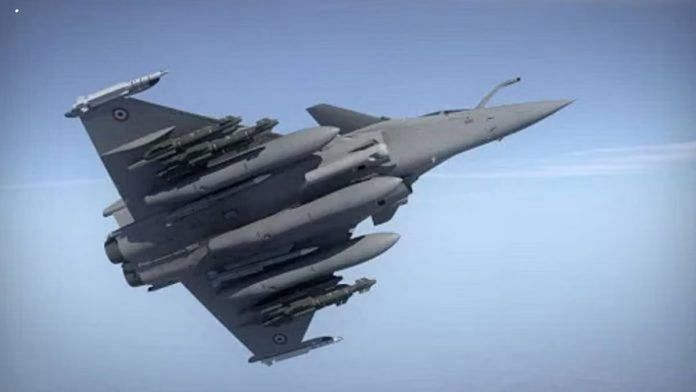This means that by 2030, India will be operating 62 Rafale fighters including the 36 procured for the Indian Air Force in 2016.
The contract was formally inked between Joint Secretary in charge of Maritime Systems Dinesh Kumar and Eric Trappier, CEO of French aviation major Dassault Aviation.
The event was also attended by Defence Secretary Rajesh Kumar Singh, and French Ambassador to India Dr. Thierry Mathou, among other officials.
The contract for 22 Rafale M single seater and four Rafale D twin seater includes training, simulator, associated equipment, weapons, and Performance Based Logistics (PBL) for a period of 5 years.
The IGA also includes additional equipment for the existing Rafale fleet of the Indian Air Force.
“In line with the Government’s thrust on , the agreement includes Transfer of Technology for integration of indigenous weapons in India,” a statement released by the Defence Ministry said.
Defence sources told ThePrint that ASTRA Mk1 Air-to-Air Beyond Visual Range Missile will be integrated through an Indian partner.
The deal also includes setting up of a production facility for Rafale fuselage, as well as Maintenance, Repair and Overhaul (MRO) facilities for aircraft engine, sensors and weapons in in India.
Manufactured by Dassault Aviation, the Rafale M is a marinised Aircraft Carrier borne combat ready aircraft with proven operational capability in maritime scenario.
It will help the Indian Navy to be an operational twin aircraft carrier force. The Navy currently uses the MiG 29K off INS Vikramaditya but the Russian fighters have a poor record when it comes to availability and has frequent engine troubles.
It also lacked the more potent fire power that modern naval fighters have.
The delivery of these aircraft would commence in 2028 and would be completed by 2030, with the crew undergoing training in India as well as France.
Defence sources explained that the Rafale M and those acquired by IAF in 2016 have major commonalities and both will be able to complement each other.
“Rafale-Marine has commonality with the Rafale being operated by IAF. Its procurement will substantially enhance joint operational capability, besides optimising training and logistics for the aircraft for both Indian Navy and IAF. The induction would lead to the addition of a potent force multiplier to the Indian Navy’s aircraft carriers, substantially boosting the nation’s air power at sea,” the Defence Ministry statement said.
For the Indian Navy, the induction of Rafale M aircraft will substantially boost its air power at sea, with the addition of this potent force multiplier to the Indian Navy’s Aircraft Carriers, they added.
Sources said that as per the agreement, Dassault Aviation will showcase a Rafale M with Indian specific enhancement in 18 months.
The India specific enhancements include strengthening of the under carriage, helmet mounted displays among some others.
ThePrint was the on 7 December, 2022, that the Indian Navy had chosen the Rafale Marine over the Boeing F/A-18 Super Hornet and that contrary to other media reports, the deal would be inked in April and not during Prime Minister Narendra Modi to France in March.
The contract follows the July 2023 announcement of the selection of the Rafale Marine, of which the Indian Navy will be the first user outside France, after an international consultation. It confirms the Indian authorities’ satisfaction with the aircraft’s capabilities and their desire to broaden the spectrum of its operational use, Dassault Aviation said in a statement.
This new acquisition testifies to the importance of the strategic relationship between India and France and the recognition of the Rafale as an essential vector of national sovereignty.
India is also working on the Twin Engine Deck Based Fighter (TEDBF), a project under scrutiny by the National Security Council Secretariat (NSCS).
The Navy had initially moved a proposal for 145 TEDBFs, basing their requirement for a three-carrier force.
However, the government asked the Indian Navy to project requirements on the basis of two-aircraft carriers as of now.
Accordingly, fresh numbers projected are about 87 TEDBFs.
The Navy, Aeronautical Development Agency (ADA) and the relevant agencies were working on the three prototypes of the Tejas Navy which is being funded by the earmarked budget for the Tejas Navy.
The Navy has identified 14 essential upgrades it needed on the TEDBF, including automatic landing and take-off features that the Tejas Navy is short of.
Four of the 14 technologies identified have been tested on the Tejas Navy and have been accepted.
(Edited by Zinnia Ray Chaudhuri)








